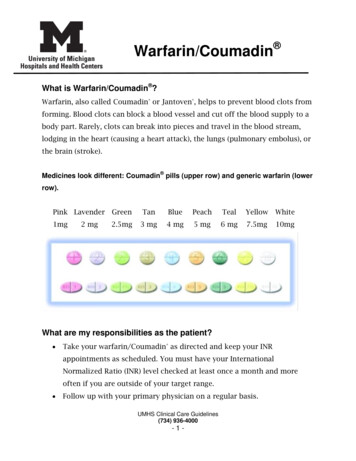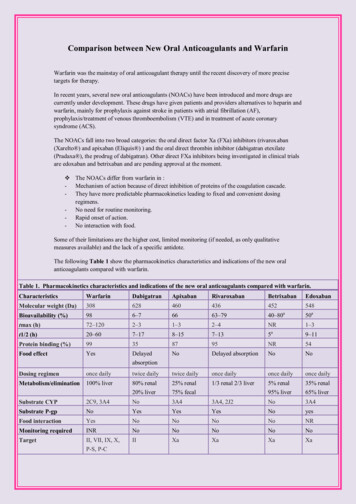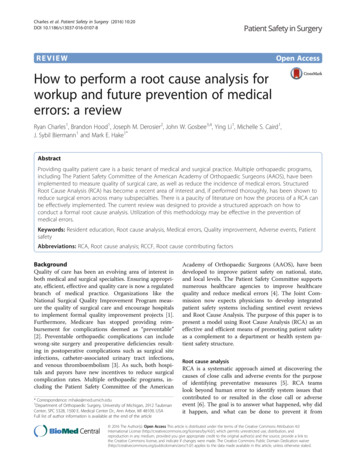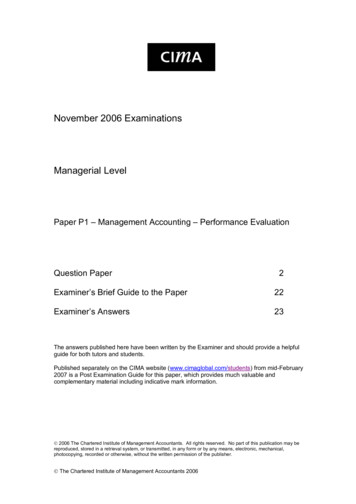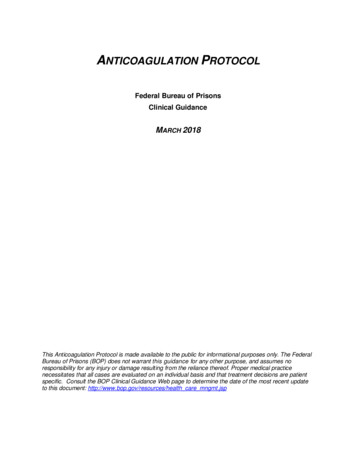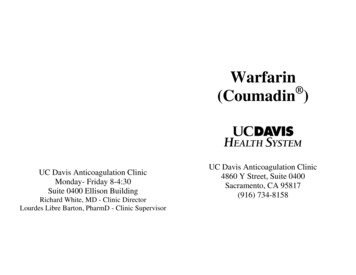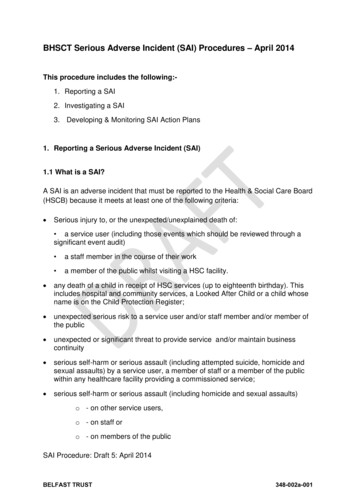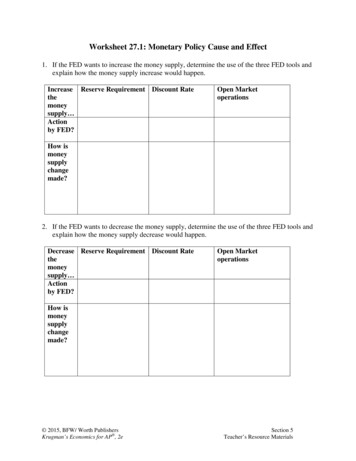
Transcription
Shields et al. BMC Family Practice(2019) EARCH ARTICLEOpen AccessStandardized warfarin monitoringdecreases adverse drug reactionsLisa B. E. Shields1* , Paula Fowler2, Diane M. Siemens2, Douglas J. Lorenz3, Kenneth C. Wilson2,Steven T. Hester2 and Joshua T. Honaker2AbstractBackground: While warfarin is the most commonly prescribed medication to prevent thromboembolic disorders,the risk of adverse drug reactions (ADR) poses a serious concern. This prospective study evaluated how primarycare providers (PCP) and cardiologists at our Institution managed patients treated with warfarin with the goal ofdecreasing the number of warfarin ADRs.Methods: A multidisciplinary anticoagulation task force was established at our Institution in 2014 to standardizewarfarin monitoring and management. Between 2013 and 2017, we analyzed patients who were prescribedwarfarin by their PCP or cardiologist upon hospital discharge and in the ambulatory setting to determine theinternational normalized ratio (INR) within 5, 10, and 30 days after discharge, time in therapeutic range (TTR),number of severe warfarin ADRs, and total and average cost reduction of all severe warfarin ADRs to determinewhether there was an organizational cost savings following the implementation of standardized warfarin care.Results: The warfarin ADR rate significantly decreased over the 5-year period, from 3.8 to 0.98% (p 0.0001). Theproportion of warfarin prescriptions out of all anticoagulants significantly decreased, from 72.2 to 42.1% (p 0.001).The proportion of individuals who received an INR at 5, 10, and 30 days after hospital discharge compared to thetotal number of patients prescribed warfarin significantly increased (p 0.001). The total cost of severe warfarinADRs decreased by 57.6% between 2013 and 2017.Conclusions: This study serves as a model to reduce the number of severe warfarin ADRs by the following tactics:(1) educating PCPs and cardiologists about evidence-based guidelines for warfarin management, (2) increasing theuse of our Institution’s electronic warfarin module, and (3) enhancing patient compliance with obtaining INR.Keywords: Family practice, Primary care provider, Cardiologist, Warfarin, Adverse drug reactionBackgroundThe epidemiology of anticoagulant prescriptions hasbeen rapidly changing over the past decade. Warfarin,a vitamin K antagonist, has historically been the mostfrequently used oral anticoagulant in the world forpatients with venous thrombosis, pulmonary embolism, atrial fibrillation, prosthetic heart valves, recurrent myocardial infarction, and stroke [1–7].Thromboembolic disorders significantly contribute tomorbidity and mortality. The direct oral anticoagulants (DOACs) have a lower incidence of major* Correspondence: LBES@earthlink.net1Norton Neuroscience Institute, Norton Healthcare, 210 East Gray Street, Suite1102, Louisville, KY 40202, USAFull list of author information is available at the end of the articlebleeding than warfarin, minor drug and food interactions, rapid onset and offset, short half-life, and stablepharmacokinetics eliminating the need for regularmonitoring and dose adjustment [8, 9]. It has beenreported that the prevalence of warfarin use decreaseed from 69.8% in 2008 to 42.2% in 2014 paralleledwith an increase in the DOAC rivaroxaban from 1.3%in 2010 to 12.1% in 2011 [1].The decision whether to initiate warfarin therapyshould weigh the potential risks (hemorrhage, druginteractions, and routine monitoring requirements)and benefits (prevention of thromboembolic event) onan individual basis [10]. According to the Stroke Prevention in Atrial Fibrillation trial, the rate of majorbleeding for patients treated with warfarin is 2.3% per The Author(s). 2019 Open Access This article is distributed under the terms of the Creative Commons Attribution 4.0International License (http://creativecommons.org/licenses/by/4.0/), which permits unrestricted use, distribution, andreproduction in any medium, provided you give appropriate credit to the original author(s) and the source, provide a link tothe Creative Commons license, and indicate if changes were made. The Creative Commons Public Domain Dedication o/1.0/) applies to the data made available in this article, unless otherwise stated.
Shields et al. BMC Family Practice(2019) 20:151year [11]. The incidence of hemorrhage in patientstreated with warfarin is directly related to the adequacy of control [5]. The generic prothrombin timeor protime (PT) historically has been used to monitorwarfarin levels. To ensure a consistent and standardized model for PT, the World Health Organization in1982 developed the international normalized ratio(INR) [12–14]. INR monitoring is performed oftenwhen warfarin therapy is initiated until a level in theoptimal therapeutic range is attained [3, 15–17]. Closemonitoring of warfarin is integral to the managementof patients to maintain anticoagulation within thetherapeutic window [18].The Rosendaal method is commonly used to determine time in therapeutic range (TTR), specifically, anINR between 2.0 and 3.0 [19]. This method calculatesthe percentage of time a patient’s INR is within thedesired therapeutic range as well as INR-specific incidence rates of either thromboembolic or hemorrhagicevents. It also determines the optimal pharmacologicaleffects of anticoagulation and monitors both the outcomes and compliance of patients.An anticoagulation task force was established at ourInstitution in 2014 aimed at educating PCPs and cardiologists about evidence-based guidelines for warfarin management, increasing the use of our Institution’selectronic warfarin module, and enhancing patient compliance with obtaining INRs. The primary objective ofour study was to decrease the number of severe warfarinADRs. Additional objectives included whether the establishment of the anticoagulation task force had a positiveeffect on TTR and severe ADRs. We hypothesized thatthe numerous strategies established by the anticoagulation task force such as providers using the electronicwarfarin module and patients’ obtaining timely INRs andfollow-up visits with their provider would positively impact our leading objective of reducing warfarin ADRs.In the current study, we present our findings of thenumber of patients prescribed warfarin at hospital discharge and who obtained an INR within 5, 10, and 30days of hospital discharge, the TTR, the number of patients treated with warfarin compared to other anticoagulant medications, the use of the electronic healthmodule by PCPs and cardiologists, and the number andcost change of severe warfarin ADR events.MethodsUnder an institutional review board-approved protocol, our prospective study (January 1, 2013- December31, 2017) investigated the number of severe warfarinADRs after hospital discharge and the management ofpatients prescribed warfarin by approximately 200PCPs and 48 cardiologists in an ambulatory setting atour Institution. The study design was a trend analysisPage 2 of 7in which the data were derived from a comprehensiverecords review involving all prescriptions of anticoagulants at our Institution over this 5-year time period.Prior to the initiation of this study, our Institutionobserved that warfarin was the leading medication associated with ADRs. Our Institution defined a severeADR as one in which the patient outcome was death,life-threatening (real risk of dying), hospitalization(initial or prolonged), disability (significant, persistent,or permanent), congenital anomaly, or requiring intervention to prevent permanent impairment or damage.Patients who were solely evaluated in the EmergencyDepartment (ED) and not admitted to the hospitaldid not experience a severe ADR. Established at ourInstitution in 2014, the anticoagulation task forceaimed to improve adherence of evidence-based management guidelines established by the American College of Cardiology and to standardize monitoring andmanagement of warfarin by implementing defineddosing algorithms and regulating treatment strategieswith INRs with the goal of decreasing the number ofwarfarin ADRs (Table 1). The task force consisted ofthe following disciplines: ambulatory adult PCP, cardiology, adult hospitalists, clinical effectiveness engineers, and information technology, pharmacy,hospital, and ambulatory operations.The warfarin data were evaluated over 5 years: (1)baseline - prior to the anticoagulation task force (1/1/2013–12/31/2013) and (2) 1–4 years later (1/1/2014–12/231/2017). Numerous measures were implementedat our Institution following the initiation of the taskforce (Table 2). The electronic warfarin module is atemplate build software that utilizes the electronicmedical record software application Epic which maybe accessed by treating physicians at all times. Priorto anticoagulation task force, providers monitoredtheir patients’ INRs without the use of the warfarinmodule in Epic. The electronic warfarin module addsand archives lab results, displays data trends, and offers standardized recommendations and guidelinesTable 1 Goals of the anticoagulation task force at ourInstitutionDecrease the number of severe warfarin ADRsEducate PCPs about the electronic warfarin module in EpicStandardize monitoring and management of warfarin by improvingadherence of evidence-based guidelines advocated by the AmericanCollege of CardiologyImplement defined warfarin dosing algorithmsEnhance patient compliance with obtaining INRs to ensure that theyremain in the TTRDecrease costs related to warfarin-related readmissionsADR Adverse drug reaction, PCP Primary care provider, INR Internationalnormalized ratio, TTR Time in therapeutic range
Shields et al. BMC Family Practice(2019) 20:151Page 3 of 7Table 2 Measures implemented at our Institution following theinitiation of the anticoagulation task force to standardizewarfarin monitoring and managementthe actual costs of severe warfarin ADRs and, therefore,we present the cost savings as a percentage change.The electronic warfarin module in Epic at our Institution adds andarchives lab results, displays data trends, and offers standardizedrecommendations and guidelines regarding the appropriatemanagement of warfarinStatistical analysisEducational video and link inform PCPs about how to use the electronicwarfarin module, specifically, how to monitor their patients’ INRs toremain in the TTRHyperlink in Epic indicates appropriate warfarin dosing protocols asestablished by the American College of CardiologyPCPs learn how to educate patients about warfarin useBPAs and a visual calendar regarding future visit follow-ups, timely labdraws, and patient education appear in the electronic warfarin modulein the electronic medical record when a provider orders warfarinA visual calendar and after-visit summary permit patients to view theirprevious INR values, upcoming appointments, and warfarin dosingPCP Primary care providers, INR International normalized ratio, TTR Time intherapeutic range, BPA Best practice alertregarding the appropriate management of warfarin. Byeducating providers about the warfarin module andincorporating this module in their daily practice, itwas easier and more reliable to monitor INRs. Additionally, providers were able to observe trends in relation to the module usage, TTRs, and patientstreated with warfarin. Special attention focused ondramatic changes in a patient’s INR results, necessitating more frequent PCP visits. Following the initiation of the task force, PCPs were educated aboutnumerous topics, including (1) a video and linkinforming PCPs about how to use the electronic warfarin module, specifically, how to monitor their patients’ INRs to ensure that they remain in the TTR,(2) a hyperlink on Epic indicating the appropriatewarfarin dosing protocols as established by theAmerican College of Cardiology, and (3) how to educate their patients about warfarin use, particularlyhow to contact their PCPs for the medication. Furthermore, a visual calendar and after-visit summarypermit patients to view their previous INR values, upcoming appointments, and warfarin dosing.A modified Rosendaal method was used to determine theTTR [19]. This method calculates a patient’s TTR by incorporating the frequency of INR measurements and thecorresponding INR values against the patient’s INR goals.The Rosendaal method assumes that changes between consecutive INR measurements are linear over time.The total and average cost reduction of all severe warfarin ADRs was calculated to determine whether therewas an organizational cost savings following the implementation of standardized warfarin care. The average costwas per patient discharged with warfarin who experienceda severe warfarin ADR. Our Institution does not provideA chi-square test for trend was utilized to evaluate forall trends in proportions over time except for trend forTTR which used the Poisson generalized linear model.The change in the distribution of type of provider (PCP,cardiologist, or other medical specialties) over time wasevaluated with a chi-square test. The change in the number of warfarin prescriptions over time was evaluatedwith the Mann-Kendall test for trend. A p 0.05 indicated statistical significance.ResultsWarfarin prescribed at hospital dischargeThe number of patients prescribed warfarin at hospitaldischarge decreased over our 5-year study, from a totalof 925 at baseline in 2013 to 665 in 2017 (Table 3). Themajority of patients were given warfarin by their PCP.Other medical specialties that prescribed warfarin athospital discharge include neurosurgery, spinal surgery,general surgery, hematology, oncology, and gastroenterology. The distribution of the types of physicians (PCPs,cardiologist, other specialties) prescribing warfarin wassignificantly different over the 5 years (p 0.001), however, there was no discernible trend over time in thisdistribution.Prescriptions of warfarin compared to otheranticoagulantsThe proportion of warfarin prescriptions out all anticoagulants decreased over the 5 years, from 72.2 to 42.1%(p 0.001) (Table 3).INR within 5, 10, and 30 days of hospital discharge andtime in therapeutic rangeThe proportion of patients who had an INR within 5, 10,and 30 days of hospital discharge out of the total numberof patients who were prescribed warfarin by all PCPs,cardiologists, and other specialties significantly increasedover the 5-year period (p 0.01 for each time period)(Table 3). At 5-days post-discharge, the proportion alsosignificantly increased for PCPs and cardiology (p 0.001for both). The proportion significantly increased for PCPsat 10- and 30-days post-discharge (p 0.001 for both).Electronic warfarin module usage and time in therapeuticrangeUse of the electronic health module significantly increased between baseline in 2013 and 2017 for bothPCPs (68.9 to 84.2%, p 0.001) and cardiologists (76.5 to85.4%, p 0.001). The TTR is represented by a ratio ofthe number of days the INR was in the therapeutic range
Shields et al. BMC Family Practice(2019) 20:151Page 4 of 7Table 3 Warfarin module metrics in the electronic medical record at our InstitutionMetric2013 (Baseline)2014201520162017P-valueWarfarin prescribed at hospital dischargeN 925N 1027N 954N 740N 665p 0.001PCP753 (81.4%)878 (85.5%)735 (77.0%)617 (83.4%)487 (73.2%)Cardiology62 (6.7%)38 (3.7%)20 (2.1%)24 (3.2%)59 (8.87%)Others110 (11.9%)111 (10.8%)199 (20.9%)99 (13.4%)108 1.5%)2247/5135(43.8%)2650/6301(42.1%)Number of patients on warfarin compared toother anticoagulantsp 0.001N 308 (33.3%) N 376 (36.6%) N 353 (37.0%) N 309 (41.8%) N 293 (44.0%) p 0.01INR within 5 days of hospital dischargePCP250 (33.2%)316 (36.0%)297 (39.4%)253 (41.0%)218 (44.8%)Cardiology14 (22.6%)15 (39.5%)7 (35.0%)12 (50.0%)32 (54.2%)Others44 (40.0%)45 (40.5%)49 (24.6%)44 (44.4%)40 (37.0%)N 456 (49.3%) N 573 (55.8%) N 510 (53.5%) N 460 (62.2%) N 397 (59.7%) p 0.01INR within 10 days of hospital dischargePCP369 (49.0%)487 (55.5%)409 (55.6%)382 (61.9%)299 (61.4%)Cardiology28 (45.0%)25 (65.8%)13 (65.0%)15 (62.5%)37 (62.7%)Others59 (53.6%)61 (55.0%)88 (44.2%)63 (63.6%)54 (50.0%)N 684 (73.9%) N 792 (77.1%) N 742 (77.8%) N 622 (84.1%) N 537 (80.8%) p 0.01INR within 30 days of hospital dischargePCP550 (73.0%)680 (77.4%)586 (77.8%)516 (83.6%)402 (82.5%)Cardiology51 (82.2%)33 (86.8%)19 (95.0%)22 (91.7%)49 (83%)Others83 (75.4%)79 (71.2%)137 (68.8%)84 (84.8%)78 108,414(62.5%)Cardiology452,620/658,264 439,047/643,609 458,181/670,446 444,692/646,642 431,225/626,779 p 0.182(68.8%)(68.2%)(68.3%)(68.8%)(68.8%)Time in therapeutic rangep 0.191Electronic health module p 8/10,844(80.7%)8737/10,338(84.5%)8127/9520(85.4%)p 0.001PCP Primary care provider, INR International normalized ratio, ADR Adverse drug reactionfor all patients treated with warfarin to the total numberof days all patients were treated with warfarin. The TTRwas significantly higher for cardiologists compared toPCPs for all 5 years of our study (p 0.0001).Severe adverse drug reactions attributed to warfarinThe number of severe ADRs due to warfarin decreased atour Institution between 2013 and 2017, from 63 to 26(Table 4). The warfarin ADR rate reflects the ratio of thenumber of severe warfarin ADRs to the total number ofwarfarin prescriptions. The warfarin ADR rate significantlydecreased over the 5-year period of this study, from 3.8% atbaseline in 2013 to 0.98% in 2017 (p 0.0001; Table 4).Total cost change of severe warfarin ADRsBetween 2013 and 2017, the total and average cost of allsevere warfarin ADRs decreased by 57.6 and 20.3%,respectively.DiscussionThe goal of warfarin therapy is to prescribe the lowest dosenecessary to prevent clot formation or expansion whileTable 4 Adverse drug reactions attributed to warfarin at our InstitutionMetric2013 (Baseline)2014201520162017Number of severe warfarin ADRs63/165837/207354/229428/224726/2650Warfarin ADR rate3.80%1.78%2.35%1.25%0.98%P-valuep 0.0001ADR Adverse drug reaction, Severe ADR: death, life-threatening (real risk of dying), hospitalization (initial or prolonged), disability (significant, persistent, orpermanent), congenital anomaly, or requiring intervention to prevent permanent impairment or damage
Shields et al. BMC Family Practice(2019) 20:151averting the ADR associated with over-anticoagulation [4].In this study, we present three strategies to reduce thenumber of severe warfarin ADRs and cost: (1) educatingPCPs and cardiologists about evidence-based managementguidelines established by the American College of Cardiology for warfarin management, (2) increasing the use ofthe warfarin module by PCPs and cardiologists, and (3) enhancing patient compliance with obtaining INR after hospital discharge.Time in therapeutic range and INRTTR is an important measure to assess the safety and efficacy of warfarin treatment [20–23]. Maximizing TTR,specifically maintaining an INR between 2 and 3, playsthe most critical role in preventing stroke, majorhemorrhage, or death [24]. The average TTR has rangedfrom 56% in retrospective studies to 65% in randomizedcontrolled trials [21, 23]. Similar to the present study,Pokorney and colleagues used a modified Rosendaalmethod to determine the TTR of patients with atrial fibrillation on warfarin [21]. Patients with the highest riskof bleeding and stroke had the lowest TTRs.In our current study, the proportion of patients whohad an INR within 5, 10, and 30 days of hospital discharge out the total number of patients who were prescribed warfarin by all PCPs, cardiologists, and otherspecialties significantly increased over the 5-year period(p 0.01 for each time period). Interestingly, the proportion significantly increased for PCPs at 5, 10, and 30 dayspost-discharge (p 0.001 for each time period).Adverse drug reaction involving warfarinThe management of ADRs in the United States costs approximately 30.1 billion annually due to the increasednumber of hospital visits and prolonged hospital stay[25]. Patient non-compliance may lead to an ADR causing negative clinical and economic consequences, including a reduced quality of life [26]. Warfarin is one ofthe most commonly prescribed medications that causedrug-related adverse events leading to ED visits [27, 28].While predictors of warfarin-associated adverse eventshave been reported in hospitalized patients [29–32], apaucity of studies addressed attempts to reduce warfarinADRs in an outpatient setting [33, 34]. Salinero andHyman reported a model of reducing warfarin ADRswith a nurse led anticoagulation clinic in South Miami,Florida [34]. An interdisciplinary team with physicians,nurses, and nurse practitioners was established in response to the increased number of hospital admissionsfor warfarin toxicity. Physicians referred their warfarinpatients to the anticoagulation clinic with evidencebased clinical warfarin management, replete with dosingadjustments and follow-up intervals. Following the implementation of the anticoagulation clinic, the numberPage 5 of 7of hospital admissions related to warfarin ADRs decreased from 27 in 2006 to 9 in 2015. The goal of reducing warfarin ADRs was accomplished in both Salineroand Hyman’s work and the present study, specifically,through an anticoagulation clinic in the former and anelectronic warfarin module in ours.Utilizing lab-based patient-specific INR and pharmacybased patient specific Vitamin K triggers, Lederer andBest investigated warfarin adverse drug events (ADEs) inboth inpatient and outpatient settings of Novant HealthSystem [33]. They developed process improvement andmedication management protocols for patients treatedwith warfarin. The two trigger interventions included (1)the laboratory identified all patients with an INR 3 and(2) that pharmacy identified all patients who receivedVitamin K as a warfarin reversal agent. Triggered chartsunderwent harm classification assignments based on theNational Coordinating Council for Medication ErrorReporting and Prevention Index. These authors reportedreductions in warfarin ADEs for both inpatients (45%)and outpatients (52%) [33].The present study closely reflects the goals and findings of Lederer and Best. Physician education as to thepotential problems associated with warfarin management was the primary intervention in both studies. Following the multidisciplinary meeting in 2014, PCPs andcardiologists at our Institution were taught how to usethe warfarin electronic module to monitor their patientstreated with warfarin. Our results confirmed that use ofthe electronic health module significantly increased between baseline in 2013 and 2017 for both PCPs (68.9 to84.2%, p 0.001) and cardiologists (76.5 to 85.4%, p 0.001). Over this 5-year period, the number of patientsprescribed warfarin at hospital discharge decreased, froma total of 925 at baseline in 2013 to 665 in 2017. Furthermore, the proportion of warfarin prescriptions outall anticoagulants decreased over the 5 years, from 72.2to 42.1% (p 0.001). We attribute the decreased percentage to a trend for patients to initiate safer DOACs thatdid not require retrieval of INRs. The increased numberof patients was most likely due to the larger patientpopulation treated at our Institution over the course ofour study. Furthermore, a large population of patientscontinued to consume warfarin primarily due to thelower cost of this medication.As PCPs and cardiologists used the warfarin module morefrequently and were educated about evidence-based guidelines for warfarin monitoring and as more patients obtainedtheir INR after hospital discharge, there was a simultaneousdecrease in the number of severe warfarin ADRs and warfarin ADR rate at our Institution. This significant reductionin warfarin ADRs may reflect the consistent management ofoutliers with the defined algorithms such that their timeoutside of the TTR was less likely to result in patient harm.
Shields et al. BMC Family Practice(2019) 20:151The decline in the ADR rate may also be due to noncompliant unstable patients who have discontinued warfarin andinitiated DOACs or other anticoagulants. Some patientswho experienced a warfarin-related ADR may have been referred to another facility outside of our Institution, and wewere unable to capture the number of patients who mayhave done so. Therefore, these patients would have beenmissed from our study. In addition, the total and averagecost of all severe warfarin ADRs decreased by 57.6 and20.3%, respectively, between 2013 and 2017.Strengths and limitations of the present studyOur 5-year study serves as a unique model for incorporating an electronic warfarin module into clinical familypractice with the goal of closely monitoring INR to increase the time in the therapeutic window thereby decreasing warfarin ADRs, ED visits, readmissions, costs,and morbidity and mortality. The initiative presented inthis study established standardized warfarin monitoringand management processes at our Institution by disseminating evidence-based guidelines to the PCPs and cardiologists. The robust warfarin module plays a valuablerole in many respects, including the ease of trackingINR, offering a hyperlink to the American College ofCardiology guidelines to warfarin therapy, and providinga visual calendar with an after-visit summary to alert patients of their previous INR values, upcoming appointments, and dosing regimen. This model has served toboth educate PCPs about appropriate dosing and monitoring of warfarin levels and increase patient compliancewith INR visits.As our warfarin module in the electronic medical record is in its early stages at our Institution, both the average TTR and the number of patients obtaining INR at 5,10, and 30 days after being prescribed warfarin at hospital discharge should dramatically rise with continueduse of the warfarin module. As the patient populationtreated with warfarin in this study was not a staticgroup, volatility in the TTR until it was stabilized in newpatients may play a role in the TTR remaining in thelow 60% for the 5 years of this study. Additionally, someof the statistical tests, in particular those for cardiologyand the other medical specialties, may not have beensufficiently powered to detect trends due to the smallernumber of patients.As the objective of our study was to observe thechanges in relation to the implementation of the variousmeasures aimed at decreasing warfarin ADRs, we didnot have a control group. While the lack of a controlgroup was a limitation in the present study, we believedthat our efforts would be valuable for the entire population. Therefore, we wanted to implement the constructive strategies throughout our Institution for all patientstreated with warfarin instead of withholding positivePage 6 of 7modifications from certain members of our community.Thus, we are unable to demonstrate the differences between the group which benefitted from alterations incorporated by the anticoagulation task force and acontrol group.Further intervention is warranted to teach PCPs attheir respective clinics to use the warfarin module, toensure appointments for INR testing are made at thetime of hospital discharge, and to arrange consultationswith a nurse navigator for patients who are dischargedwith a history of severe warfarin ADRs. Continued observation of the various metrics in the warfarin modulein the EMR is necessary to incorporate revisions. Weaim to establish a staffing unit at our hospital which willensure that patients are discharged with a filled bottle ofwarfarin, a warfarin prescription, and their subsequentINR schedule. PCPs at our Institution are actively pursuing a standardized and centralized anticoagulation management center model. This site will be directed bydedicated nurse practitioners with pharmacy support tomanage warfarin lab values and adjust dosing accordingly.ConclusionClose observation of warfarin levels is imperative to mitigate the potentially devastating sequela of a thromboembolic event. This article serves as a model to reduce thenumber of severe warfarin ADRs by educating PCPs andcardiologists about evidence-based guidelines for warfarinmanagement and enhancing patient compliance withobtaining INR. Standardization of warfarin monitoringand management plays a crucial role in reducing the number of severe warfarin ADRs in a primary care setting in ametropolitan community.AbbreviationsADR: Adverse drug reaction; DOAC: Direct oral anticoagulants;INR: International normalized ratio; PCP: Primary care provider; PT: Protime;TTR: Time in therapeutic rangeAcknowledgmentsWe acknowledge Norton Healthcare for their continued support.Authors’ contributionsLBES made substantial contributions to the conception and design, analyzedand interpreted the data, performed the literature search, and was the majorcontributor in the writing of the manuscript. PF, DMS, DJL, KCW, STH, andJTH made substantial contributions to the conception and design, analyzedand interpreted the data, and revised the draft critically for importantintellectual content. All authors read and approved the final manuscript andhave agreed to be accountable for all aspects of the work in ensuring thatquestions related to the accuracy or integrity of any part of the work areappropriately investigated and resolved.FundingThere are no sources of funding for this work.Availability of data and materialsAll of the raw data presented in this study may be requested from thecorresponding author of this work.
Shields et al. BMC Family Practice(2019) 20:151Ethics approval and consent to participateThe University of Lo
RESEARCH ARTICLE Open Access Standardized warfarin monitoring decreases adverse drug reactions Lisa B. E. Shields1*, Paula Fowler2, Diane M. Siemens2, Douglas J. Lorenz3, Kenneth C. Wilson2, Steven T. Hester2 and Joshua T. Honaker2 Abstract Background: While warfarin is the most commonly prescribed medication to prevent thromboembolic disorders,
